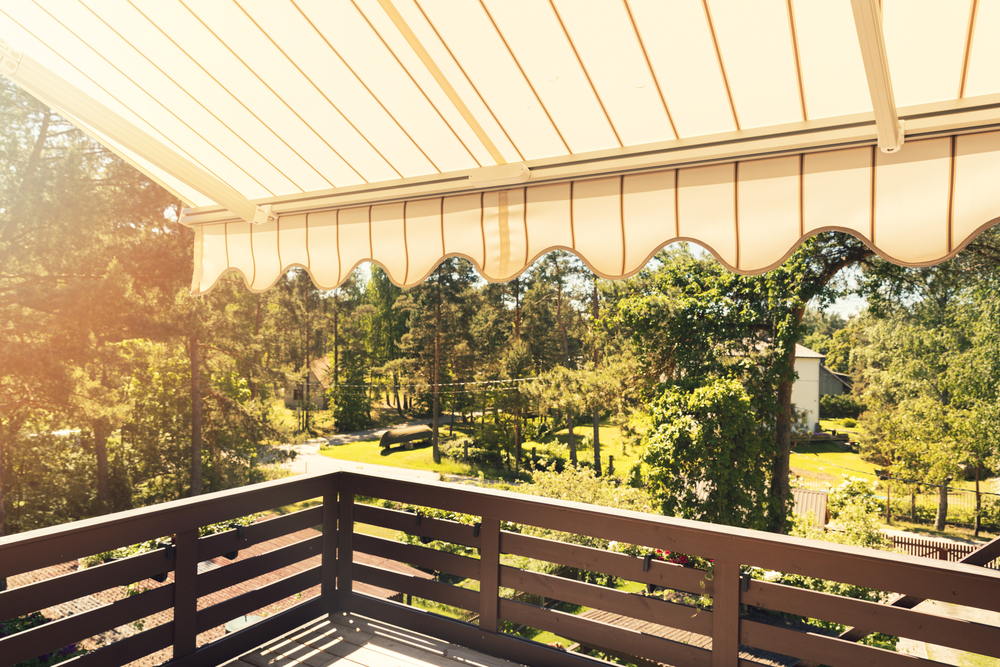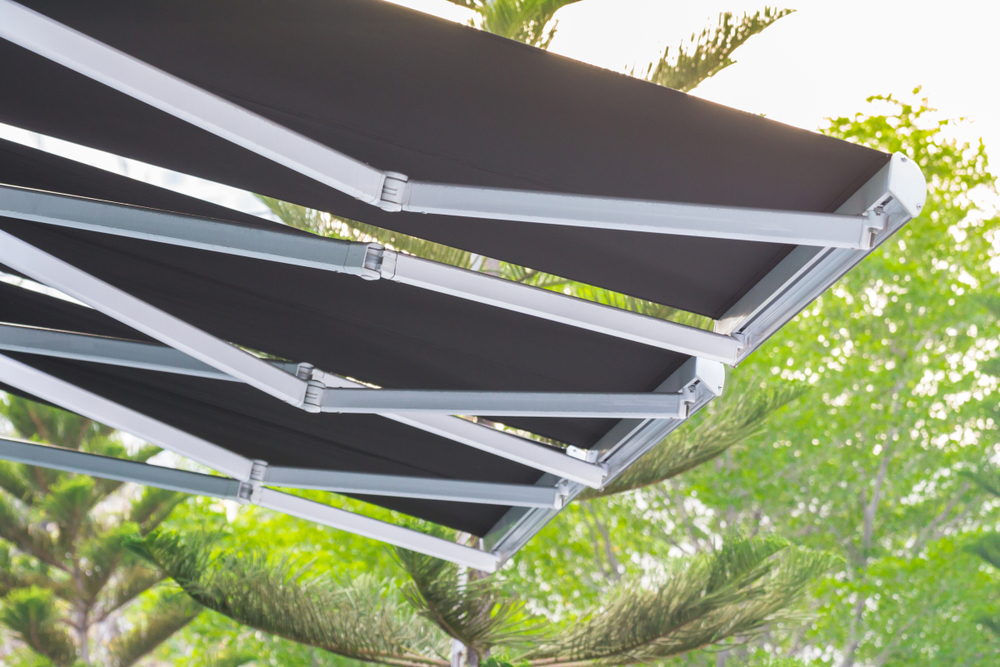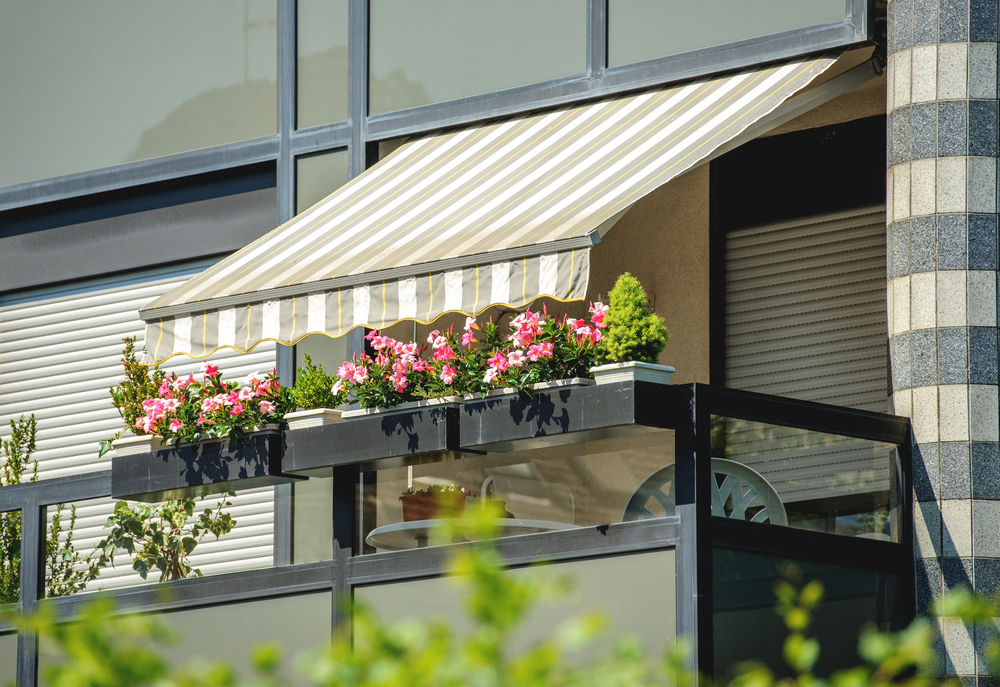It’s no secret, that navigating through eco-friendly and energy-efficient ways to design our homes can seem like a bit of a sticky wicket. We’ve had a fair go at it ourselves but stumbled upon awnings as an innovative solution in the realm of green building practices.
In this article, we’re going to reveal how the unassuming awning provides more than just shade on a hot day – it plays a generous part in sustainable construction services by improving water management and energy efficiency.
So sit tight, you’re about to discover how adding nothing more than an awning could make your home that much kinder to our beautiful environment!
Key Takeaways
- Awnings provide shade structures that reduce the need for artificial cooling systems, saving energy and lowering costs.
- Incorporating awnings made from sustainable materials into green building design promotes resource-efficient practices.
- Awnings create usable outdoor spaces, enhancing the aesthetic appeal of homes and promoting a closer connection with nature.
- Advancements in technology and materials have revolutionised green building solutions, offering homeowners a wide range of environmentally friendly options.
What are Green Buildings?
Green buildings are environmentally friendly and resource-efficient structures that have a minimal impact on the environment throughout their lifecycle.
Definition
Green buildings reflect an innovative construction approach that minimises the impact on our environment. They are built, renovated, operated or reused in a manner that creates a healthy and resource-efficient environment.
Designed with energy efficiency at their core, these constructions effectively manage water usage, utilise sustainable materials, promote good indoor air quality and contribute positively to the local community.
A more in-depth understanding of green buildings can help us make smarter choices when it comes to construction.

Importance
Exploring Awnings as Green Building Solutions is of great importance to homeowners who are looking for environmentally friendly and resource-efficient building options. By incorporating awnings into their design, homeowners can enjoy several benefits.
Firstly, awnings provide shade structures that help to reduce the amount of direct sunlight entering the building, thereby reducing the need for artificial cooling systems and saving energy.
Secondly, awnings made from sustainable materials such as aluminium canopies contribute to a more eco-friendly construction process. Lastly, by creating usable outdoor spaces, awnings enhance the aesthetic appeal of homes while promoting a closer connection with nature.
Applications
Awnings has a wide range of applications in green building design. They can be used to create shade structures that protect from the sun, reducing the need for artificial cooling and lowering energy consumption.
Awnings also contribute to the aesthetic appeal of buildings, enhancing their visual appeal while providing usable outdoor spaces. Additionally, awnings can be combined with internal and external shutters to regulate natural light and optimise passive solar design strategies.
Overall, incorporating awnings into green building projects offers sustainable solutions that improve energy efficiency, enhance comfort levels, and promote environmentally friendly practices.
Benefits
Using awnings as green building solutions offers several benefits for homeowners. Firstly, awnings provide shade structures that can significantly reduce the need for artificial cooling systems, leading to lower energy consumption and cost savings.
This is particularly important in hot climates where cooling expenses can be substantial. Secondly, awnings contribute to a more environmentally friendly building design by maximising the use of natural daylight while minimising direct sunlight.
This not only reduces reliance on artificial lighting but also helps regulate indoor temperatures, reducing the need for heating or cooling systems. Additionally, awnings create usable outdoor spaces that enhance the aesthetic appeal of homes and promote a connection with nature.
By incorporating renewable materials such as aluminium canopies and sustainable construction services into their design, awning-based green buildings support resource-efficient practices throughout their lifecycle.
Limitations
While awnings offer numerous benefits as green building solutions, it is important to be aware of their limitations. One limitation is that awnings may not be suitable for all types of buildings or architectural styles.
Depending on the design and structure, some buildings may not have adequate space or structural support for installing awnings. Another limitation is that while awnings provide shade and help reduce energy consumption for cooling, they may limit sunlight penetration in colder climates and reduce natural lighting indoors.
Additionally, certain types of awning materials may require regular maintenance and replacement over time, which can add to the overall cost of owning and maintaining a green building with awnings.
History of Green Buildings
Green building practices have evolved, with major milestones paving the way for more sustainable construction techniques and materials.
Evolution of green building practices
Green building practices have come a long way over the years. We have seen a shift towards more environmentally friendly and resource-efficient construction methods. Today, green buildings incorporate measures that prioritise sustainability throughout their entire lifecycle.
From design to construction and operation, these buildings strive to minimise their impact on the environment while maximising energy efficiency. This evolution has been driven by advancements in technology and materials, as well as a growing awareness of the need for sustainable solutions.
As a result, we now have access to innovative designs and materials that not only enhance the aesthetic appeal of our homes but also contribute to a healthier planet. With the help of sustainable construction services, such as certified awnings made from aluminium canopies or other green building materials, homeowners can incorporate these eco-friendly solutions into their properties.
Major milestones
Over the years, there have been major milestones in the development and adoption of green building practices. These milestones have played a crucial role in shaping the way we design and construct environmentally friendly buildings.
For example, the introduction of certification programs like Green Star has helped to standardise sustainable building practices and recognise projects that meet specific environmental criteria.
Additionally, advancements in technology and materials have allowed for more innovative and efficient construction methods, leading to greater energy efficiency and reduced environmental impact.

New and Future Developments in Green Buildings
Advancements in technology and materials continue to drive sustainable development, enhancing the overall environmental performance of buildings.
Advancements in technology and materials
Advancements in technology and materials have revolutionised the way we design and construct buildings, especially when it comes to green building solutions. With innovations like aluminium canopies and sustainable construction services, homeowners now have access to a wide range of environmentally friendly options.
These awnings not only provide shade and reduce heat gain, but they also enhance the aesthetic appeal of the building. Additionally, with features like internal and external shutters, blinds, and passive solar design techniques, homeowners can create energy-efficient homes that contribute to sustainability efforts.
By incorporating these advancements into their green building designs, homeowners can enjoy comfortable indoor spaces while minimising their environmental impact.
Impact on sustainability
Exploring awnings as green building solutions has a significant impact on sustainability. By incorporating shade structures like aluminium canopies, we can create environmentally friendly buildings that are resource-efficient.
Awnings not only provide aesthetic appeal but also offer usable outdoor spaces while reducing the need for energy-consuming cooling systems. These passive solar design features help in heating and cooling homes efficiently, resulting in reduced energy consumption and carbon emissions.
Additionally, awnings contribute to water management by preventing excessive rainwater from entering the building and helping to maintain sustainable water usage. With their use of green building materials and techniques, including eco-friendly architecture and renewable energy solutions, awnings play a vital role in creating sustainable building designs for a greener future.
Exploring Awnings as Green Building Solutions
In this section, we will delve into the benefits of using awnings in green buildings, explore innovative designs and materials, and highlight sustainable construction services.
Benefits of using awnings in green buildings
Using awnings in green building projects offers numerous benefits. Awnings provide shade structures that help to reduce heat gain, improving energy efficiency by reducing the need for air conditioning.
With their durable and sustainable nature, awnings can also extend the lifespan of a building by protecting windows and doors from harsh weather conditions. Additionally, awnings create usable outdoor spaces, allowing homeowners to enjoy their surroundings while minimising environmental impact.
By incorporating aluminium canopies or other innovative designs and materials, green buildings can enhance both the aesthetic appeal and sustainability of their overall design. Overall, using awnings in green building projects is a practical and eco-friendly solution that contributes to resource efficiency and environmentally conscious design practices.
Innovative designs and materials
We are excited to explore the innovative designs and materials that can be used in awnings for green building solutions. When it comes to shade structures, there is a wide range of environmentally friendly options available.
One popular choice is aluminium canopies, which not only provide shade but also have a sustainable nature. These canopies are lightweight, durable, and often made from recycled materials, making them an excellent choice for eco-conscious homeowners.
In addition to traditional awnings, other innovative designs can be incorporated into green building design. For example, some awnings now come with built-in solar panels that harness renewable energy while providing shade.
This allows homeowners to generate their electricity and reduce their reliance on the grid.
When it comes to materials, green building focuses on using sustainable and resource-efficient options. Many awning manufacturers now offer fabrics made from recycled or organic materials that are free of harmful chemicals.
These fabrics not only contribute to a healthier indoor environment but also have a lower environmental impact during production.
Sustainable construction services
Sustainable construction services offer a range of high-quality internal and external shutters, blinds, and awnings that are environmentally friendly and resource-efficient. These shade structures not only provide aesthetic appeal to green buildings but also contribute to their sustainable nature.
By incorporating aluminium canopies and innovative designs, these services help create usable outdoor spaces that promote passive solar design for heating and cooling. Additionally, they play an important role in water management by offering solutions like rainwater harvesting systems.
With their focus on eco-friendly materials and techniques, sustainable construction services contribute to the overall goal of creating energy-efficient and environmentally conscious buildings.
Incorporating Awnings in Green Building Design
Incorporating awnings in green building design is essential for achieving energy efficiency and sustainable construction practices.
Importance of structural certification
Structural certification is a crucial aspect of incorporating awnings into green building design. It ensures the safety and durability of the structure, giving homeowners peace of mind.
Certification guarantees that the awnings are installed correctly and can withstand various weather conditions. By obtaining structural certification, you can be confident that your awnings will not only provide shade and enhance energy efficiency but also meet all building codes and regulations.
So when considering incorporating awnings into green building design, don’t overlook the importance of structural certification for a secure and sustainable solution.
Influence on water management and energy efficiency
Incorporating awnings in green building design has a significant influence on water management and energy efficiency. By providing shade, awnings reduce the amount of direct sunlight entering a building, which helps to keep indoor spaces cooler naturally.
This means that homeowners can rely less on air conditioning systems, resulting in lower energy consumption and reduced electricity bills. Additionally, by minimising the amount of sunlight hitting windows and walls, awnings also help to prevent heat gain, further reducing the need for cooling systems.
In terms of water management, awnings can be designed to channel rainwater away from buildings and into storage or filtration systems for reuse in irrigation or toilet flushing. This helps to conserve water resources and reduce reliance on mains supply.
Case studies and success stories
We have come across many inspiring case studies and success stories that showcase the effectiveness of using awnings in green building design. For example, one case study involved a commercial office building that incorporated aluminium canopies as shade structures.
These canopies not only provide relief from the sun’s heat but also contribute to reducing energy consumption by minimising the need for air conditioning. Another success story featured a residential development that utilised awnings to create usable outdoor spaces and enhance the aesthetic appeal of the buildings.
By incorporating internal and external shutters, blinds, and awnings, this development achieved passive solar design principles which resulted in significant savings on heating and cooling costs.
Discover Green Building Solutions Today
In conclusion, awnings offer a sustainable and aesthetically pleasing solution for green building design. With their shade structures and passive solar design capabilities, they contribute to energy efficiency and cooling in buildings.
Incorporating awnings into construction projects can create usable outdoor spaces while also promoting water management and environmentally friendly practices. By utilising green building materials and techniques, awnings play a vital role in creating greener and more eco-friendly buildings.

